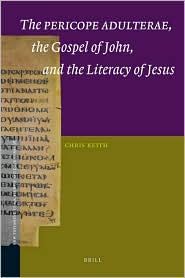
Finally on my desk: Chris Keith's new monograph, The Pericope Alduterae, the Gospel of John and the Literacy of Jesus (NTTSD 38; Leiden: Brill, 2009).
Brief description:
This book offers a new interpretation and transmission history of the "Pericope Adulterae," arguing that the an interpolator placed the story at John 7.53-8.11 in order to highlight the claim that Jesus could write (John 8.6, 8) in light of a careful reading of John's Gospel.
For table of contents and abstract, see here.
The concluding words:
In conclusion, PA's importance as a window into early Christianity perhaps parallels the degree to which earlier and present scholars have overlooked it. PA clearly was one of the most spoken, read, remembered, and transmitted stories about Jesus in the early Church, deserving its reputation as one of the most popular stories in the gospels.
Order page (Eisenbrauns) here.
So Tommy,
ReplyDeleteIt looks like it is worth reading, but is it worth buying?
We have had the Brill pricing discussion recently, so I won't go into that. However, I got mine by grace.
ReplyDeleteOK. Let me re-phrase: is it likely to be useful and something to refer to over the next thirty years? Or is it more of an argument towards a particular conclusion that I can read/browse in a library (or read reviews of)?
ReplyDeletePeter, I will have to get back to that when I have read more... I guess, however, that the main contribution here is not in textual criticism specifically.
ReplyDeleteWell on the textualcriticism email discussion list it was noted that the original PhD is on-line here:
ReplyDeletehttp://www.era.lib.ed.ac.uk/handle/1842/2595
This answers the question as to whether it is worth buying the book if you can get the PhD free on-line:
PhD: Jesus Began to Write:
Literacy, the Pericope Adulterae, and the Gospel of John (2008)
Introduction: The Most Popular Story in the Gospels
Chapter One: A History of Research on John 8.6, 8
Chapter Two: Speaking of Writing: katagra,fw and gra,fw in Hellenistic,
Jewish, and New Testament Contexts
Chapter Three: Writing and Gradations of Literacy
Chapter Four: Scribal Literacy in the New Testament World: The Scribes (and
Pharisees) as Text-Brokers
Chapter Five: The Pericope Adulterae at John 7.53–8.11: The Location
Chapter Six: The Pericope Adulterae at John 7.53–8.11: The Preceding Context
of John 7
Chapter Seven: The Pericope Adulterae at John 7.53–8.11: The Narrative
Chapter Eight: The Pericope Adulterae at John 7.53–8.11: The (Divine) Grapho-
Literacy of Jesus
Chapter Nine: The Historical Context for the Insertion of the Pericope Adulterae
into the Gospel of John: A Proposal
Conclusion: Summary of Chapters and Directions for Future Research
Bibliography
Brill Book: The Pericope Adulterae, the Gospel of John, and the Literacy of Jesus (2009)
Introduction: The Most Popular Story in the Gospels
Chapter One: A History of Research on John 8.6, 8
Chapter Two: Speaking of Writing: καταγράφω and γράφω in Hellenistic, Jewish, and New Testament Contexts
Chapter Three: Writing and Gradations of Literacy
Chapter Four: Scribal Literacy in the New Testament World: The Scribes (and Pharisees) as Text-Brokers
Chapter Five: The Pericope Adulterae at John 7.53–8.11: The Location
Chapter Six: The Pericope Adulterae at John 7.53–8.11: The Preceding Context of John 7
Chapter Seven: The Pericope Adulterae at John 7.53–8.11: The Narrative
Chapter Eight: The Pericope Adulterae at John 7.53–8.11: The (Divine) Grapho-Literacy of Jesus
Chapter Nine: The Historical Context for the Insertion of the Pericope Adulterae into the Gospel of John: A Proposal
Conclusion: The Pericope Adulterae in the Early Church
Bibliography